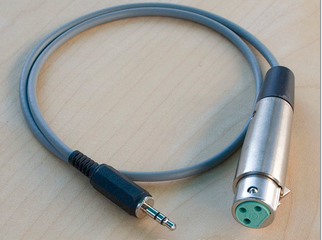Devil’s Adapter
There is a microphone adapter rattling around out there which should be avoided.

This is a Cannon XLR3 Female (A3F in Switchcraft-speak) to 1/8" (3.5mm) Tip-Ring-Sleeve audio adapter. More commonly, XLR Female to 1/8" Stereo.
What it’s not is an adapter from XLR microphone to PC soundcard, even though that’s what it looks like.
There will be a tiny portion of users that can connect that adapter between their XLR microphone and their internal soundcard and it will work just fine—everybody wins. Those people are very lucky unicorns.
Less lucky people will get badly damaged sound through low volume, high noise, distortion or DC offset and that’s the good news. Much worse, some people will produce what appears to be a good performance only to have it drop dead later, when the client or customer gets the work or when the work posts on-line. That’s the phase-cancellation curse.
There is a way to use a custom cable technique like this but it uses a different 1/8" plug (tip-sleeve, not tip-ring-sleeve) and special XLR internal wiring.
XLR pin 2 to 1/8" Tip
XLR pin 1 and XLR pin 3 to 1/8" Sleeve.
You’re good with a soldering iron and electrical tools, right?
Even that’s not recommended. If you do everything right, you will lose the XLR cable’s ability to travel long distances. No 50 foot cable runs for you. Three to five feet will be about maximum—roughly the same as a USB cable. Longer than that and buzz, hum, hiss and other noises may be a problem. The damage is unpredictable and many times permanent.
Most music suppliers can sell you 20 foot XLR cables. Those are common and in normal application work fine, but they’re a really bad idea with this adapter. You can put your long rock band cables back in the garage.
But wait, there’s more!
Doesn’t matter how good your microphone is, your sound is going to go through the normally cheap electronics in most stock soundcards. Computers today are designed for communications, conferencing and chat. Not performance art.
Koz